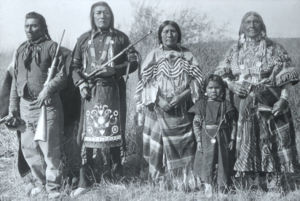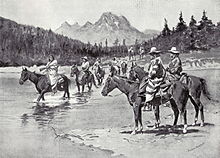Bannock people
 Bannock people in Idaho | |
| Regions with significant populations | |
|---|---|
| Languages | |
| Northern Paiute language,[1] English | |
| Religion | |
| Native American Church, Sun Dance, traditional tribal religion,[2] Christianity, Ghost Dance | |
| Related ethnic groups | |
| Northern Paiute, Northern Shoshone[3] |
The Bannock tribe of the Northern Paiute are an indigenous people of the Great Basin.[3] Their traditional lands include southeastern Oregon, southeastern Idaho,[5] western Wyoming, and southwestern Montana.[6] Today they are enrolled in the federally recognized Shoshone-Bannock Tribes of the Fort Hall Reservation of Idaho, located on the Fort Hall Indian Reservation.
History

Traditionally, Bannock traded with surrounding tribes. After their adoption of the horse in the mid-18th century, they traded horses with the Nez Perce.[7] They made pottery, utensils from mountain sheep horns, and carrying bags from salmon skin. Their petroglyphs date back before European contact, and, after the introduction of glass beads, they transferred their geometric design to beadwork. For water transport, they made tule reed rafts.[8] Prior to the late 19th century, Bannock people fished for salmon on the Snake River in Idaho and in the fall, they hunted buffalo herds. Buffalo hides provided material for tipis.[9]
The Bannock are prominent in American history due to the Bannock War of 1878. After the war, the Bannock moved onto the Fort Hall Indian Reservation with the Northern Shoshone and gradually their tribes merged. Today they are called the Shoshone-Bannock. The Bannock live on the Fort Hall Indian Reservation, 544,000 acres (2,201 km²) in Southeastern Idaho.[5] Lemhi and Northern Shoshone live with the Bannock Indians.
Notable Bannock people
- Mark Trahant, journalist
- Randy'L He-dow Teton, model
Notes
- ^ "Bannock." Countries and Their Cultures. (retrieved 14 Aug 2011)
- ^ " Northern Paiute - Religion and Expressive Culture ". Countries and Their Cultures. (retrieved 14 Aug 2011)
- ^ a b Pritzker 2000, p. 236
- ^ "History/Geography." Shoshone-Bannock Tribes. (retrieved 14 Aug 2011)
- ^ a b Chisholm 1911, Banate.
- ^ Pritzker 2000, p. 224.
- ^ Pritzker 2000, p. 226.
- ^ Pritzker 2000, p. 238.
- ^ Pritzker 2000, p. 225.
References
- Chisholm, Hugh, ed. (1911). . Encyclopædia Britannica. Vol. 3 (11th ed.). Cambridge University Press.
- Pritzker, Barry M. (2000). A Native American Encyclopedia: History, Culture, and Peoples. Oxford, England: Oxford University Press. ISBN 978-0-19-513877-1.
External links
- Shoshone-Bannock Tribes, Official Website
